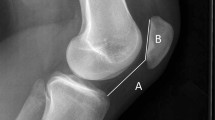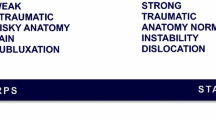Abstract
Purpose
To determine which risk factors for patellar instability contribute most relevantly to patients’ subjective disease-specific quality of life, aiming to provide implications on the overall treatment decision-making process.
Methods
A total of 182 consecutive patients (male/female 70/112; mean age 23.6 ± 7.3 years) with a history of patellar instability were prospectively enrolled in this study. Patient age, body mass index (BMI), number of dislocations, reversed dynamic patellar apprehension test (ReDPAT), J-sign severity, and pathoanatomic risk factors of patellar instability were assessed. The statistical analysis evaluated the relationships among those variables and determined their ability to predict the Banff Patellofemoral Instability Instrument 2.0 (BPII 2.0) as a disease-specific quality of life measure. Using Spearman correlation, ANOVA and Fisher’s exact test, all variables with ANOVA p ≤ 0.1 or Spearman’s abs (rho) > 0.1 were entered into a multivariate linear model using backward-stepwise selection.
Results
Analysis of the individual variables’ ability to predict BPII 2.0 score values revealed ‘age’, ‘BMI’, ‘ReDPAT’, ‘high grade of trochlear dysplasia’, and ‘high-grade J-Sign’ as possible relevant factors. Backward-stepwise multivariate regression analysis yielded a final parsimonious model that included the factors ‘BMI’ and ‘J-Sign (Grade II and III)’ as the most relevant parameters influencing BPII 2.0 score values (adjusted R2 = 0.418; p < 0.001), with a cutoff value for BMI found at 28 kg/m2 (p = 0.01).
Conclusion
The results of this study indicate that in patients with lateral patellar instability, a high-grade J-sign and an increased BMI significantly impact subjective disease-specific quality of life.
Level of evidence
Level IV.
Similar content being viewed by others
Data availability
Raw data can be made available upon request. Data analysis protocols are listed in the “Statistical Analysis Supplement file”.
References
Hiemstra LA, Kerslake S, Lafave MR (2019) Influence of risky pathoanatomy and demographic factors on clinical outcomes after isolated medial patellofemoral ligament reconstruction: a regression analysis. Am J Sports Med 47(12):2904–2909
Post WR, Fithian DC (2018) Patellofemoral instability: a consensus statement from the AOSSM/PFF patellofemoral instability workshop. Orthop J Sport Med 6(1):1–5
Sanders TL, Pareek A, Hewett TE, Stuart MJ, Dahm DL, Krych AJ (2018) High rate of recurrent patellar dislocation in skeletally immature patients: a long-term population-based study. Knee Surg Sports Traumatol Arthrosc 26(4):1037–1043
Sanders TL, Pareek A, Hewett TE, Stuart MJ, Dahm DL, Krych AJ (2018) Incidence of first-time lateral patellar dislocation: a 21-year population-based study. Sports Health 10(2):146–151
Ling DI, Brady JM, Arendt E, Tompkins M, Agel J, Askenberger M, Balcarek P, Parikh S, Stein BES (2021) Development of a multivariable model based on individual risk factors for recurrent lateral patellar dislocation. J Bone Joint Surg Am 103(7):586–592
Liebensteiner MC, Dirisamer F, Balcarek P (2017) Guidelines for treatment of lateral patella dislocations in skeletally mature patients. Am J Orthop (Belle Mead NJ) 46(2):86–96
Weber AE, Nathani A, Dines JS, Allen AA, Shubin-Stein BE, Arendt EA, Bedi A (2016) An algorithmic approach to the management of recurrent lateral patellar dislocation. J Bone Joint Surg Am 98(5):417–427
Zimmerer A, Sobau C, Balcarek P (2018) Recent developments in evaluation and treatment of lateral patellar instability. J Exp Orthop 5(1):3
Geierlehner A, Liebensteiner M, Schöttle P, Dirisamer F (2020) Prevailing disagreement in the treatment of complex patellar instability cases: an online expert survey of the AGA Knee-Patellofemoral Committee. Knee Surg Sports Traumatol Arthrosc 28(8):2697–2705
Arendt EA, Askenberger M, Agel J, Tompkins MA (2018) Risk of redislocation after primary patellar dislocation: a clinical prediction model based on magnetic resonance imaging variables. Am J Sports Med 46(14):3385–3390
Balcarek P, Oberthür S, Hopfensitz S, Frosch S, Walde TA, Wachowski MM, Schüttrumpf JP, Stürmer KM (2014) Which patellae are likely to redislocate? Knee Surg Sports Traumatol Arthrosc 22(10):2308–2314
Balcarek P, Rehn S, Howells NR, Eldridge JD, Kita K, Dejour D, Nelitz M, Banke IJ, Lambrecht D, Harden M, Friede T (2017) Results of medial patellofemoral ligament reconstruction compared with trochleoplasty plus individual extensor apparatus balancing in patellar instability caused by severe trochlear dysplasia: a systematic review and meta-analysis. Knee Surg Sports Traumatol Arthrosc 25(12):3869–3877
Franciozi CE, Ambra LF, Albertoni LJB, Debieux P, Rezende FC, de Oliveira MA, de Castro FM, Luzo MVM (2017) Increased femoral anteversion influence over surgically treated recurrent patellar instability patients. Arthroscopy 33(3):633–640
Hevesi M, Heidenreich MJ, Camp CL, Hewett TE, Stuart MJ, Dahm DL, Krych AJ (2019) The recurrent instability of the patella score: a statistically based model for prediction of long-term recurrence risk after first-time dislocation. Arthroscopy 35(2):537–543
Colatruglio M, Flanigan DC, Harangody S, Duerr RA, Kaeding CC, Magnussen RA (2020) Identifying patients with patella alta and/or severe trochlear dysplasia through the presence of patellar apprehension in higher degrees of flexion. Orthop J Sport Med. https://doi.org/10.1177/2325967120925486
Zhang ZJ, Zhang H, Song GY, Wang X, Zhang J, Zheng T, Ni Q, Feng H (2020) A high-grade J sign is more likely to yield higher postoperative patellar laxity and residual maltracking in patients with recurrent patellar dislocation treated with derotational distal femoral osteotomy. Am J Sports Med 48(1):117–127
Zhang ZJ, Zhang H, Song GY, Zheng T, Feng H (2020) A pre-operative grade 3 J-sign adversely affects short-term clinical outcome and is more likely to yield MPFL residual graft laxity in recurrent patellar dislocation. Knee Surg Sports Traumatol Arthrosc 28(7):2147–2156
Zimmermann F, Liebensteiner MC, Balcarek P (2019) The reversed dynamic patellar apprehension test mimics anatomical complexity in lateral patellar instability. Knee Surg Sports Traumatol Arthrosc 27(2):604–610
Sappey-Marinier E, Sonnery-Cottet B, O’Loughlin P, Ouanezar H, Fernandes LR, Kouevidjin B, Thaunat M (2019) Clinical outcomes and predictive factors for failure with isolated MPFL reconstruction for recurrent patellar instability: a series of 211 reconstructions with a minimum follow-up of 3 years. Am J Sports Med 47(6):1323–1330
Post WR (1999) Clinical evaluation of patients with patellofemoral disorders. Arthroscopy 15(8):841–851
Dejour D, Le Coultre B (2007) Osteotomies in patello-femoral instabilities. Sports Med Arthrosc Rev 15(1):39–46
Caton J, Deschamps G, Chambat P, Lerat JL, Dejour H (1982) Les rotules basses: a propos de 128 observations. Rev Chir Orthop Reparatrice Appar Mot 68(5):317–325
Seitlinger G, Scheurecker G, Högler R, Labey L, Innocenti B, Hofmann S (2012) Tibial tubercle-posterior cruciate ligament distance: a new measurement to define the position of the tibial tubercle in patients with patellar dislocation. Am J Sports Med 40(5):1119–1125
Holme TJ, Henckel J, Hartshorn K, Cobb JP, Hart AJ (2015) Computed tomography scanogram compared to long leg radiograph for determining axial knee alignment. Acta Orthop 86(4):440–443
Becher C, Attal R, Balcarek P, Dirisamer F, Liebensteiner M, Pagenstert G, Schöttle P, Seitlinger G, Wagner D (2018) Successful adaption of the Banff Patella Instability Instrument (BPII) 2.0 into German. Knee Surg Sports Traumatol Arthrosc 26(9):2679–2684
Peduzzi P, Concato J, Kemper E, Holford TR, Feinstein AR (1996) A simulation study of the number of events per variable in logistic regression analysis. J Clin Epidemiol 49(12):1373–1379
Tanaka MJ, Elias JJ, Williams AA, Demehri S, Cosgarea AJ (2016) Characterization of patellar maltracking using dynamic kinematic CT imaging in patients with patellar instability. Knee Surg Sports Traumatol Arthrosc 24(11):3634–3641
Biyani R, Elias JJ, Saranathan A, Feng H, Guseila LM, Morscher MA, Jones KC (2014) Anatomical factors influencing patellar tracking in the unstable patellofemoral joint. Knee Surg Sports Traumatol Arthrosc 22(10):2334–2341
Pal S, Besier TF, Beaupre GS, Fredericson M, Delp SL, Gold GE (2013) Patellar maltracking is prevalent among patellofemoral pain subjects with patella alta: an upright, weightbearing MRI study. J Orthop Res 31(3):448–457
Tanaka MJ, Elias JJ, Williams AA, Carrino JA, Cosgarea AJ (2015) Correlation between changes in tibial tuberosity-trochlear groove distance and patellar position during active knee extension on dynamic kinematic computed tomographic imaging. Arthroscopy 31(9):1748–1755
Zhang ZJ, Zhang H, Song GY, Zheng T, Ni QK, Feng H (2020) Increased femoral anteversion is associated with inferior clinical outcomes after MPFL reconstruction and combined tibial tubercle osteotomy for the treatment of recurrent patellar instability. Knee Surg Sports Traumatol Arthrosc 28(7):2261–2269
Pal S, Draper CE, Fredericson M, Gold GE, Delp SL, Beaupre GS, Besier TF (2011) Patellar maltracking correlates with vastus medialis activation delay in patellofemoral pain patients. Am J Sports Med 39(3):590–598
Elias JJ, Jones KC, Rezvanifar SC, Gabra JN, Morscher MA, Cosgarea AJ (2018) Dynamic tracking influenced by anatomy following medial patellofemoral ligament reconstruction: computational simulation. Knee 25(2):262–270
Gobbi RG, Demange MK, de Ávila LFR, Filho JABA, Moreno RA, Gutierrez MA, de Sá RM, Tírico LEP, Pécora JR, Camanho GL (2017) Patellar tracking after isolated medial patellofemoral ligament reconstruction: dynamic evaluation using computed tomography. Knee Surg Sports Traumatol Arthrosc 25(10):3197–3205
Balcarek P, Radebold T, Schulz X, Vogel D (2019) Geometry of torsional malalignment syndrome: trochlear dysplasia but not torsion predicts lateral patellar instability. Orthop J Sport Med. https://doi.org/10.1177/2325967119829790
Fitzpatrick CK, Steensen RN, Tumuluri A, Trinh T, Bentley J, Rullkoetter PJ (2016) Computational analysis of factors contributing to patellar dislocation. J Orthop Res 34(3):444–453
Liebensteiner MC, Ressler J, Seitlinger G, Djurdjevic T, El Attal R, Ferlic PW (2016) High femoral anteversion is related to femoral trochlea dysplasia. Arthroscopy 32(11):2295–2299
Dowsey MM, Liew D, Stoney JD, Choong PF (2010) The impact of pre-operative obesity on weight change and outcome in total knee replacement: a prospective study of 529 consecutive patients. J Bone Joint Surg Br 92(4):513–520
Snaebjörnsson T, Svantesson E, Sundemo D, Westin O, Sansone M, Engebretsen L, Hamrin-Senorski E (2019) Young age and high BMI are predictors of early revision surgery after primary anterior cruciate ligament reconstruction: a cohort study from the Swedish and Norwegian knee ligament registries based on 30,747 patients. Knee Surg Sports Traumatol Arthrosc 27(11):3583–3591
Ulusoy GR, Kızılgöz V, Sivrioğlu AK (2019) Relationship between body mass index and articular injuries accompanying primary anterior cruciate ligament tear in male knees: a retrospective observational study. J Knee Surg 33(11):1157–1162
Hart HF, Barton CJ, Khan KM, Riel H, Crossley KM (2017) Is body mass index associated with patellofemoral pain and patellofemoral osteoarthritis? A systematic review and meta-regression and analysis. Br J Sports Med 51(10):781–790
Vincent HK, Lamb KM, Day TI, Tillman SM, Vincent KR, George SZ (2010) Morbid obesity is associated with fear of movement and lower quality of life in patients with knee pain-related diagnoses. PM R 2(8):713–722
Fontaine KR, Barofsky I (2001) Obesity and health-related quality of life. Obes Rev 2(3):173–182
Taylor VH, Forhan M, Vigod SN, McIntyre RS, Morrison KM (2013) The impact of obesity on quality of life. Best Pract Res Clin Endocrinol Metab 27(2):139–146
Hiemstra LA, O’Brien CL, Lafave MR, Kerslake S (2021) Common physical examination tests for patellofemoral instability demonstrate weak inter-rater reliability. Arthrosc Sports Med Rehabil 3(3):673–677
Smith TO, Clark A, Neda S, Arendt EA, Post WR, Grelsamer RP, Dejour D, Alqvist KF, Donell ST (2012) The intra- and inter-observer reliability of the physical examination methods used to assess patients with patellofemoral joint instability. Knee 19(4):404–410
Zimmermann F, Börtlein J, Milinkovic DD, Balcarek P (2020) Patient-reported outcomes after revision surgery for failed medial patellofemoral ligament reconstruction: a matched-pair analysis including correction of predisposing factors. Am J Sports Med 48(14):3566–3572
Funding
No funding has been received for conducting this study.
Author information
Authors and Affiliations
Contributions
DDM: data acquisition, data analysis, data interpretation, writing the paper, final approval; IJ: statistical analysis, data interpretation, final approval; FZ: data analysis, data interpretation, final approval; PB: study design, data analysis, data interpretation, writing the paper, final approval.
Corresponding author
Ethics declarations
Conflict of interest
No benefits in any form have been received or will be received from a commercial party related directly or indirectly to the subject of this article. The authors declare that they have no competing interests.
Ethical approval
This study was approved by the Ethics Committee of Baden-Württemberg, Germany (F-2019-070).
Consent to participate
Not applicable.
Consent for publication
Not applicable.
Additional information
Publisher's Note
Springer Nature remains neutral with regard to jurisdictional claims in published maps and institutional affiliations.
Supplementary Information
Below is the link to the electronic supplementary material.
Rights and permissions
About this article
Cite this article
Milinkovic, D.D., Jovandic, I., Zimmermann, F. et al. The J-sign and the body mass index determine the disease-specific quality of life in patients with lateral patellar instability. Knee Surg Sports Traumatol Arthrosc 30, 1672–1678 (2022). https://doi.org/10.1007/s00167-021-06705-6
Received:
Accepted:
Published:
Issue Date:
DOI: https://doi.org/10.1007/s00167-021-06705-6




